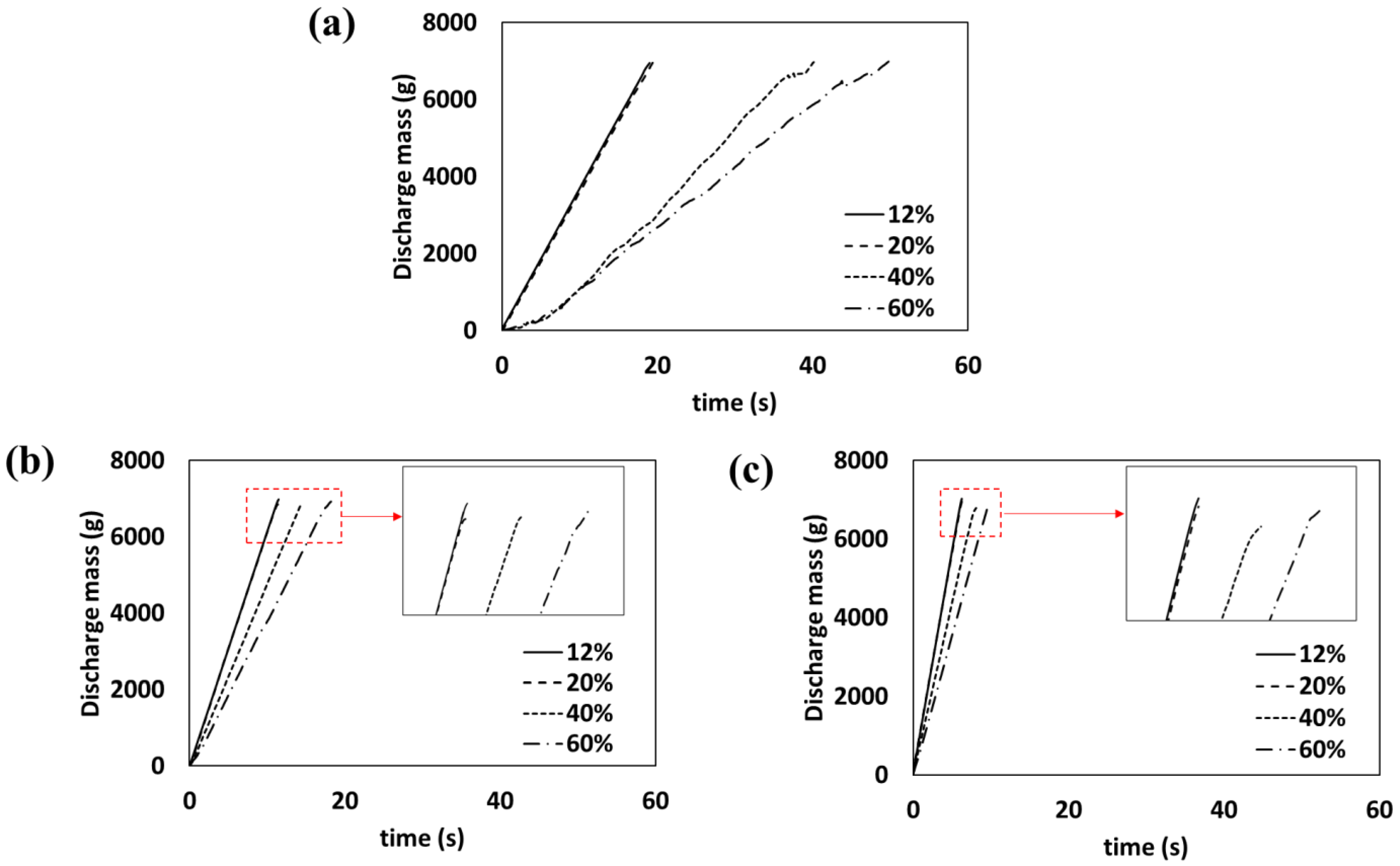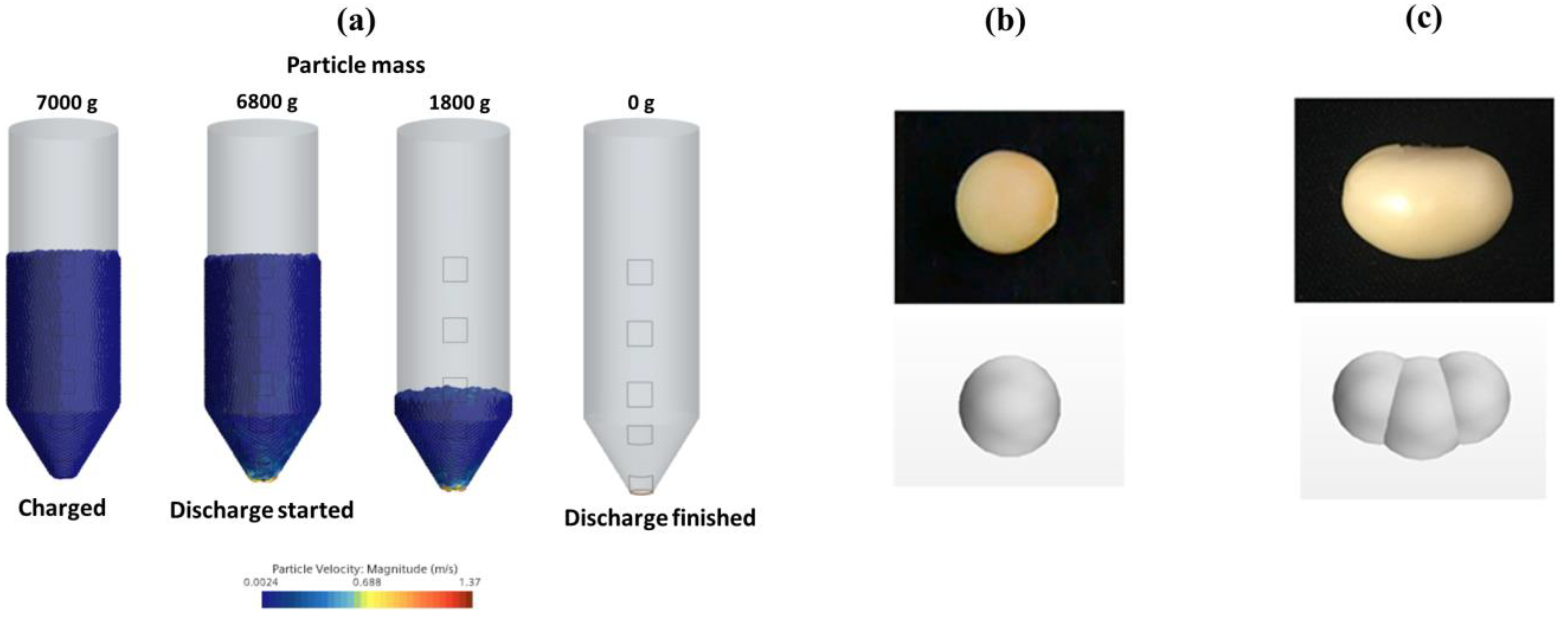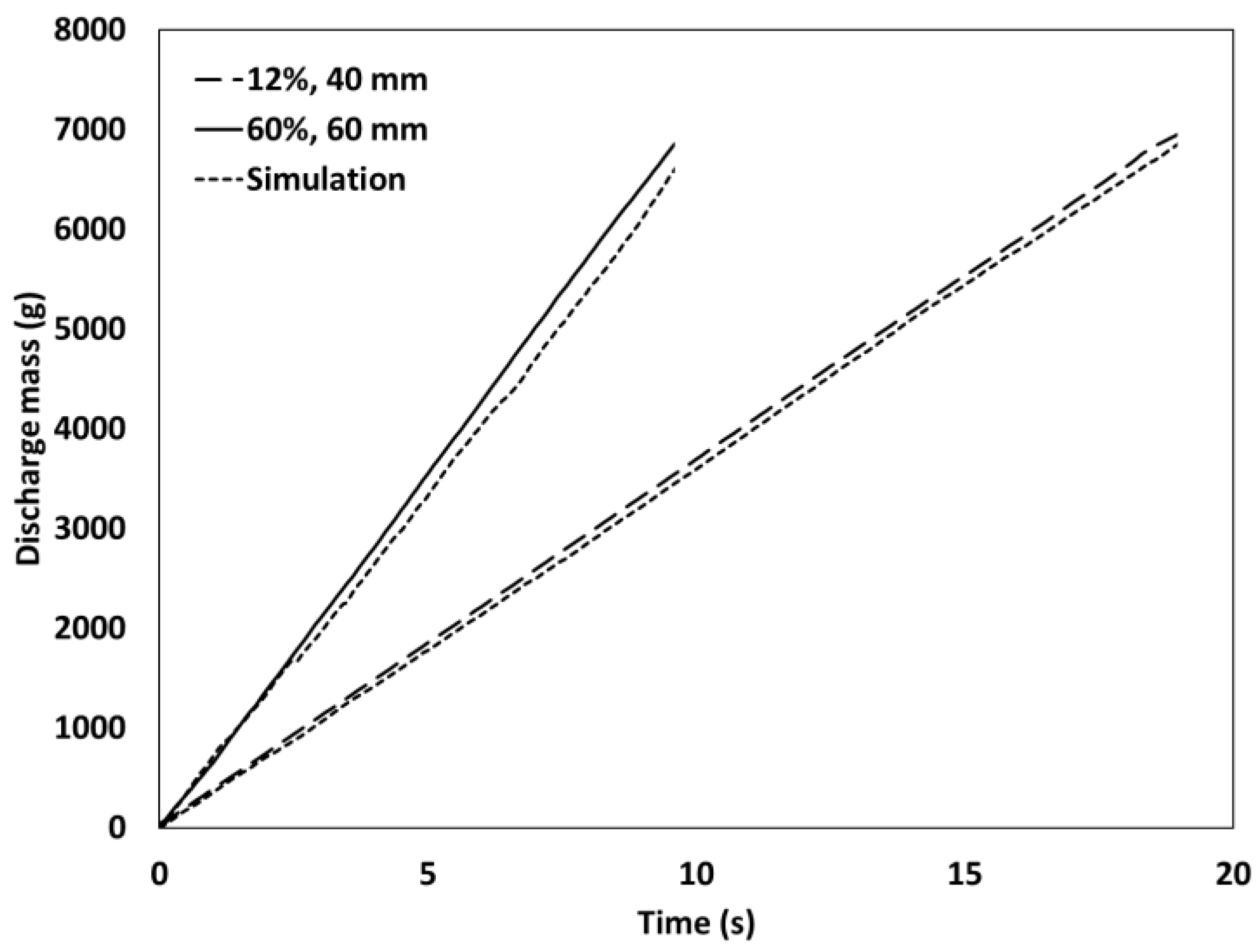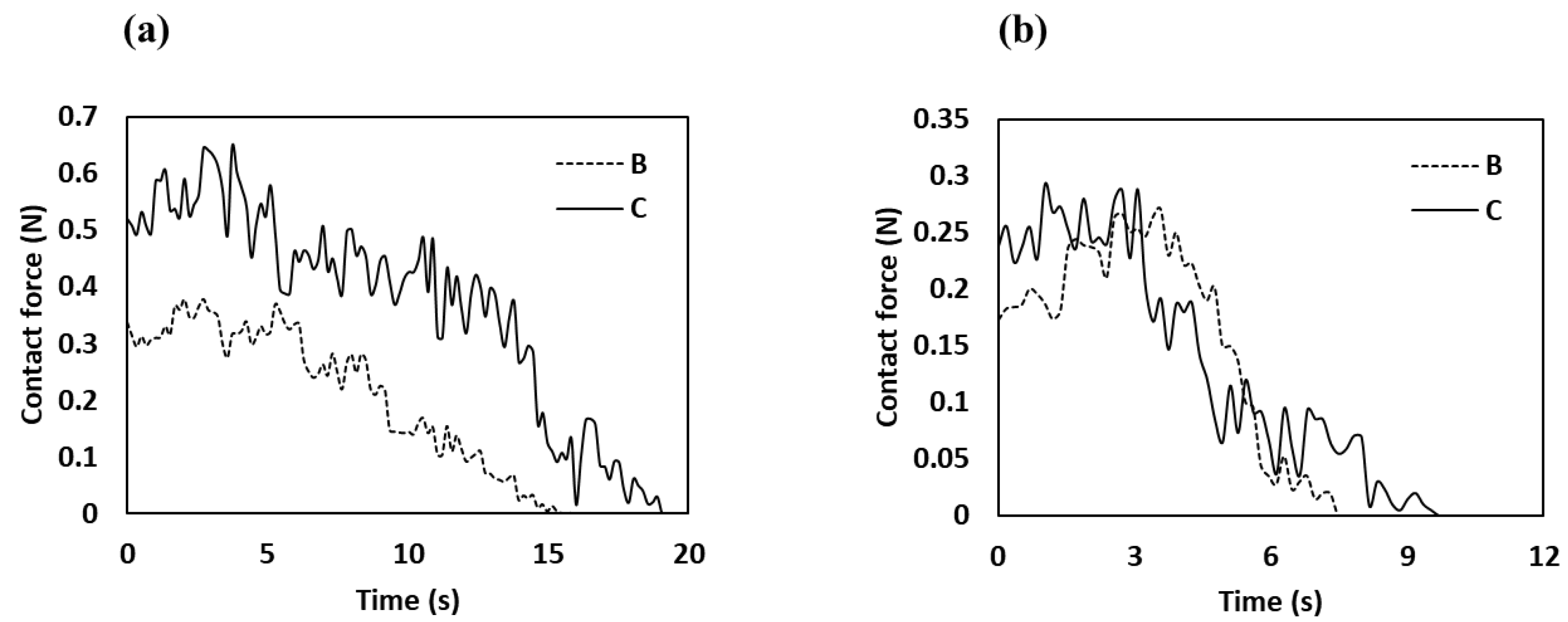Determination and Validation of Discrete Element Model Parameters of Soybeans with Various Moisture Content for the Discharge Simulation from a Cylindrical Model Silo
Abstract
1. Introduction
2. Materials and Methods
2.1. Soybean Soaking
2.2. Particle Properties of Soybeans
2.2.1. Geometry of the Grains
2.2.2. Poisson’s Ratio and Young’s Modulus
2.2.3. Particle–Particle (ep) and Particle–Wall Coefficients of Restitution (ew)
2.2.4. Particle–Wall Coefficient of Static Friction (μw)
2.2.5. Particle–Wall Coefficient of Rolling Resistance (μr)
2.3. Experimental Equipment
2.4. DEM Simulation
2.5. Statistical Analysis
3. Results and Discussion
3.1. Physical Properties of Soybeans with Various Moisture Content
3.1.1. Shape and Size
3.1.2. Poisson’s Ratio and Young’s Modulus
3.1.3. Coefficients of Restitution
3.1.4. Coefficient of Friction
3.2. Discharge Characteristics of Soybeans from the Silo
3.2.1. Flow Rates of Soybeans with Different Moisture Content at Different Silo Orifice Sizes
3.2.2. Flow Patterns in the Silo during Discharge
3.3. DEM Simulation of Soybean Discharge
4. Conclusions
Supplementary Materials
Author Contributions
Funding
Data Availability Statement
Conflicts of Interest
References
- Isanga, J.; Zhang, G. Soybean bioactive components and their implications to health—A review. Food Rev. Int. 2008, 24, 252–276. [Google Scholar] [CrossRef]
- Bayram, M.; Öner, M.D.; Kaya, A. Influence of soaking on the dimensions and colour of soybean for bulgur production. J. Food Eng. 2004, 61, 331–339. [Google Scholar] [CrossRef]
- Davies, R.M.; El-Okene, A.M. Moisture-dependent physical propeties of soybeans. Int. Agrophys. 2009, 23, 299–303. [Google Scholar]
- Kashaninejad, M.; Ahmadi, M.; Daraei, A.; Chabra, D. Handling and frictional characteristics of soybean as a function of moisture content and variety. Powder Technol. 2008, 188, 1–8. [Google Scholar] [CrossRef]
- Boac, J.M.; Casada, M.E.; Maghirang, R.G.; Harner, J.P. Material and Interaction Properties of Selected Grains and Oilseeds for Modeling Discrete Particles; American Society of Agricultural and Biological Engineers: Reno, NV, USA, 2009. [Google Scholar]
- Horabik, J.; Molenda, M. Parameters and contact models for DEM simulations of agricultural granular materials: A review. Biosyst. Eng. 2016, 147, 206–225. [Google Scholar] [CrossRef]
- Cheng, Z.; Leal, J.H.; Hartford, C.E.; Carson, J.W.; Donohoe, B.S.; Craig, D.A.; Xia, Y.; Daniel, R.C.; Ajayi, O.O.; Semelsberger, T.A. Flow behavior characterization of biomass Feedstocks. Powder Technol. 2021, 387, 156–180. [Google Scholar] [CrossRef]
- Hirshfeld, D.; Rapaport, D.C. Granular flow from a silo: Discrete-particle simulations in three dimensions. Eur. Phys. J. E 2001, 4, 193–199. [Google Scholar] [CrossRef]
- Thompson, S.A.; Ross, I.J. Compressibility and frictional coefficients of wheat. Trans. ASAE 1983, 26, 1171–1176. [Google Scholar] [CrossRef]
- Balevičius, R.; Kačianauskas, R.; Mroz, Z.; Sielamowicz, I. Analysis and DEM simulation of granular material flow patterns in hopper models of different shapes. Adv. Powder Technol. 2011, 22, 226–235. [Google Scholar] [CrossRef]
- González-Montellano, C.; Ramírez, Á.; Gallego, E.; Ayuga, F. Validation and experimental calibration of 3D discrete element models for the simulation of the discharge flow in silos. Chem. Eng. Sci. 2011, 66, 5116–5126. [Google Scholar] [CrossRef]
- Parafiniuk, P.; Molenda, M.; Horabik, J. Discharge of rapeseeds from a model silo: Physical testing and discrete element method simulations. Comput. Electron. Agric. 2013, 97, 40–46. [Google Scholar] [CrossRef]
- Xu, T.; Yu, J.; Yu, Y.; Wang, Y. A modelling and verification approach for soybean seed particles using the discrete element method. Adv. Powder Technol. 2018, 29, 3274–3290. [Google Scholar] [CrossRef]
- Wang, J.; Xu, C.; Xu, W.; Fu, Z.; Wang, Q.; Tang, H. Discrete element method simulation of rice grain motion during discharge with an auger operated at various inclinations. Biosyst. Eng. 2022, 223, 97–115. [Google Scholar] [CrossRef]
- González-Montellano, C.; Fuentes, J.M.; Ayuga-Téllez, E.; Ayuga, F. Determination of the mechanical properties of maize grains and olives required for use in DEM simulations. J. Food Eng. 2012, 111, 553–562. [Google Scholar] [CrossRef]
- Ghodki, B.M.; Goswami, T.K. DEM simulation of flow of black pepper seeds in cryogenic grinding system. J. Food Eng. 2017, 196, 36–51. [Google Scholar] [CrossRef]
- Ketterhagen, W.R.; Bharadwaj, R.; Hancock, B.C. The coefficient of rolling resistance (CoRR) of some pharmaceutical tablets. Int. J. Pharm. 2010, 392, 107–110. [Google Scholar] [CrossRef]
- González-Montellano, C.; Ayuga, F.; Ooi, J.Y. Discrete element modelling of grain flow in a planar silo: Influence of simulation parameters. Granul. Matter 2011, 13, 149–158. [Google Scholar] [CrossRef]
- Johanson, J.R. Stress and velocity fields in the gravity flow of bulk solids. J. Appl. Mech. 1964, 31, 499–506. [Google Scholar] [CrossRef]
- Tsuji, Y.; Tanaka, T.; Ishida, T. Lagrangian numerical simulation of plug flow of cohesionless particles in a horizontal pipe. Powder Technol. 1992, 71, 239–250. [Google Scholar] [CrossRef]
- Cundall, P.A.; Strack, O.D. A discrete numerical model for granular assemblies. Geotechnique 1979, 29, 47–65. [Google Scholar] [CrossRef]
- Zhao, Y.; Yang, S.; Zhang, L.; Chew, J.W. Understanding the varying discharge rates of lognormal particle size distributions from a hopper using the discrete element method. Powder Technol. 2019, 342, 356–370. [Google Scholar] [CrossRef]
- Mishra, B.K. A review of computer simulation of tumbling mills by the discrete element method: Part I—Contact mechanics. Int. J. Miner. Process. 2003, 71, 73–93. [Google Scholar] [CrossRef]
- Soyoye, B.O.; Ademosun, O.C.; Agbetoye, L.A. Determination of some physical and mechanical properties of soybean and maize in relation to planter design. Agric. Eng. Int. CIGR J. 2018, 20, 81–89. [Google Scholar]
- Koizumi, M.; Kikuchi, K.; Isobe, S.; Ishida, N.; Naito, S.; Kano, H. Role of seed coat in imbibing soybean seeds observed by micro-magnetic resonance imaging. Ann. Bot. 2008, 102, 343–352. [Google Scholar] [CrossRef]
- Altuntas, E.; Demirtola, H. Effect of moisture content on physical properties of some grain legume seeds. N. Z. J. Crop Hortic. Sci. 2007, 35, 423–433. [Google Scholar] [CrossRef]
- Höhner, D.; Wirtz, S.; Scherer, V. Experimental and numerical investigation on the influence of particle shape and shape approximation on hopper discharge using the discrete element method. Powder Technol. 2013, 235, 614–627. [Google Scholar] [CrossRef]
- Zhong, Z.; Ooi, J.Y.; Rotter, J.M. The sensitivity of silo flow and wall stresses to filling method. Eng. Struct. 2001, 23, 756–767. [Google Scholar] [CrossRef]
- Pasha, M.; Hare, C.; Ghadiri, M.; Gunadi, A.; Piccione, P.M. Effect of particle shape on flow in discrete element method simulation of a rotary batch seed coater. Powder Technol. 2016, 296, 29–36. [Google Scholar] [CrossRef]
- Qutob, D.; Ma, F.; Peterson, C.A.; Bernards, M.A.; Gijzen, M. Structural and permeability properties of the soybean seed coat. Bot. 2008, 86, 219–227. [Google Scholar] [CrossRef]
- Wensrich, C.M.; Katterfeld, A. Rolling friction as a technique for modelling particle shape in DEM. Powder Technol. 2012, 217, 409–417. [Google Scholar] [CrossRef]
- Liu, S.D.; Zhou, Z.Y.; Zou, R.P.; Pinson, D.; Yu, A.B. Flow characteristics and discharge rate of ellipsoidal particles in a flat bottom hopper. Powder Technol. 2014, 253, 70–79. [Google Scholar] [CrossRef]












| Properties (mm) | Moisture Content (% w.b.) | |||
|---|---|---|---|---|
| 12 | 20 | 40 | 60 | |
| Length | 8.20 ± 0.31 a | 8.67 ± 0.41 a | 10.44 ± 0.45 b | 14.61 ± 0.66 c |
| Width | 7.52 ± 0.37 a | 7.61 ± 0.38 a | 7.80 ± 0.41 a | 8.74 ± 0.35 b |
| Thickness | 7.93 ± 0.32 a | 8.04 ± 0.33 a | 8.40 ± 0.35 a | 9.69 ± 0.28 b |
| Geometric mean diameter (dmean) | 7.88 ± 0.30 a | 8.09 ± 0.34 ab | 8.81 ± 0.33 b | 10.73 ± 0.32 c |
| Sphericity (ϕ) | 96.07 ± 1.92 c | 93.45 ± 1.93 c | 84.45 ± 2.62 b | 73.55 ± 1.81 a |
| Properties | Moisture Content (% w.b.) | |||
|---|---|---|---|---|
| 12 | 20 | 40 | 60 | |
| Poisson’s ratio (μ) | 0.138 ± 0.030 a | 0.151 ± 0.045 a | 0.296 ± 0.045 b | 0.106 ± 0.013 a |
| Young’s modulus (E (MPa)) | 2932.9 ± 213.8 d | 815.8 ± 83.7 c | 10.5 ± 1.4 a | 70.8 ± 8.3 b |
| Particle-particle coefficient of restitution (ep) | 0.434 ± 0.100 a | 0.455 ± 0.093 a | 0.370 ± 0.130 a | 0.323 ± 0.158 a |
| Particle-wall coefficient of restitution (ew) | 0.367 ± 0.078 a | 0.503 ± 0.032 b | 0.443 ± 0.064 ab | 0.428 ± 0.135 ab |
| Particle-wall coefficient of static friction (μw) | 0.267 ± 0.048 a | 0.319 ± 0.015 a | 0.631 ± 0.120 b | 1.971 ± 0.445 c |
| Particle-wall coefficient of rolling friction (μr) | 0.043 ± 0.018 a | 0.051 ± 0.014 a | 0.084 ± 0.021 ab | 0.140 ± 0.049 b |
| Orifice Size (mm) | Moisture Content (% w.b.) | |||||||
|---|---|---|---|---|---|---|---|---|
| Discharge Time (s) | Flow Rate (kg/s) | |||||||
| 12 | 20 | 40 | 60 | 12 | 20 | 40 | 60 | |
| 40 | 19.00 | 19.60 | 40.30 | - | 0.37 | 0.36 | 0.20 | - |
| 50 | 11.50 | 11.40 | 14.50 | 18.20 | 0.61 | 0.61 | 0.48 | 0.40 |
| 60 | 6.20 | 6.20 | 8.10 | 9.90 | 1.15 | 1.12 | 0.87 | 0.72 |
| Orifice Size (mm) | Reduced Diameter (Dred) | |||
|---|---|---|---|---|
| Moisture Content (%) | ||||
| 12 | 20 | 40 | 60 | |
| 40 | 5.08 | 4.94 | 4.54 | 3.73 |
| 50 | 6.35 | 6.18 | 5.68 | 4.66 |
| 60 | 7.61 | 7.42 | 6.81 | 5.59 |
| Orifice Size (mm) | Mass Flow Index (MFI) | |||
|---|---|---|---|---|
| Moisture Content (%) | ||||
| 12 | 20 | 40 | 60 | |
| 40 | 0.45 ± 0.01 b | 0.49 ± 0.02 b | 0.30 ± 0.02 a | - |
| 50 | 0.53 ± 0.02 c | 0.51 ± 0.02 c | 0.34 ± 0.03 b | 0.27 ± 0.02 a |
| 60 | 0.55 ± 0.02 b | 0.52 ± 0.01 b | 0.35 ± 0.02 a | 0.30 ± 0.02 a |
Publisher’s Note: MDPI stays neutral with regard to jurisdictional claims in published maps and institutional affiliations. |
© 2022 by the authors. Licensee MDPI, Basel, Switzerland. This article is an open access article distributed under the terms and conditions of the Creative Commons Attribution (CC BY) license (https://creativecommons.org/licenses/by/4.0/).
Share and Cite
Jung, H.; Yoon, W.B. Determination and Validation of Discrete Element Model Parameters of Soybeans with Various Moisture Content for the Discharge Simulation from a Cylindrical Model Silo. Processes 2022, 10, 2622. https://doi.org/10.3390/pr10122622
Jung H, Yoon WB. Determination and Validation of Discrete Element Model Parameters of Soybeans with Various Moisture Content for the Discharge Simulation from a Cylindrical Model Silo. Processes. 2022; 10(12):2622. https://doi.org/10.3390/pr10122622
Chicago/Turabian StyleJung, Hwabin, and Won Byong Yoon. 2022. "Determination and Validation of Discrete Element Model Parameters of Soybeans with Various Moisture Content for the Discharge Simulation from a Cylindrical Model Silo" Processes 10, no. 12: 2622. https://doi.org/10.3390/pr10122622
APA StyleJung, H., & Yoon, W. B. (2022). Determination and Validation of Discrete Element Model Parameters of Soybeans with Various Moisture Content for the Discharge Simulation from a Cylindrical Model Silo. Processes, 10(12), 2622. https://doi.org/10.3390/pr10122622









